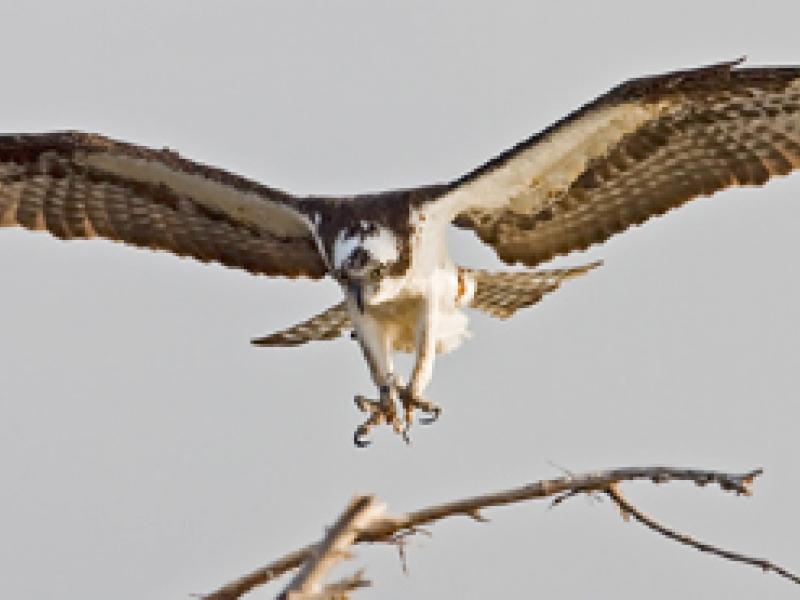Photo Credits: Terry Hartley
SCIENTIFIC NAME:
Pandion haliaetus
OTHER NAMES:
Fish Hawk
STATUS:
Breeder. Fairly common in spring, summer, and fall in Gulf Coast region, and uncommon in winter. In other regions, uncommon in spring and fall, and rare in winter and summer. Low Conservation Concern.
DESCRIPTION:
Ospreys are large raptors having a wing span from 57 to 69 inches. Depending on sex and physical condition, they can weigh from 42 to 70 ounces and at maturity reach lengths up to 23 inches. Ospreys have strong hooked beaks and large feet armed with extremely sharp talons to aid in the catching and eating of prey. Sexes are similar in appearance, with females on average being about 20% larger than males.
The feather coloration is characteristic of all adult ospreys. The head is white on top with a dark brown eye line that broadens behind the eye extending down the nape of neck, back, upper wings and tail. Dark brown mottling on the upper breast produces a necklace affect, being more defined in female ospreys. Adults have a distinctive dark brown patch underneath the wings at the carpal joint or bend in wing. The wing flight and tail feathers have a number of noticeable contrasting white and darker colored bands.
The chin, throat, breast and belly of adult ospreys are bright white. Juvenile ospreys are similar in appearance to adults but have a more speckled coloration and take on adult coloration at about 18 months of age. Adults have a yellow iris and the juveniles have an orange/red iris. Pale yellow feet and black beak are common for both sexes. The white belly, characteristic crooked wing shape and flight style of ospreys make recognizing them at a distance, relatively easy.
DISTRIBUTION:
Ospreys inhabit suitable habitat worldwide and winters and breeds on all continents except Antarctica.
HABITAT:
Fish are the primary food item of ospreys. Suitable habitats are lakes, rivers, fresh and saltwater marshes that support good fish populations, with adjacent forested areas to provide nesting and perching sites. Ospreys naturally choose large dead snag trees for nesting sites, but also readily use power poles, channel markers and other suitable man-made structures, that will support their large nests.
FEEDING HABITS:
Ospreys have anatomical adaptations to improve their fish catching abilities. Large wings that move freely at the carpel or “wrist” joint allow them to hover easily above water while watching and waiting for the exact moment to dive feet first into the water after unsuspecting fish. Ospreys’ feathers are very oily, to keep them dry when diving into the water after prey. Other adaptations include efficient nasal valves that prevent water from entering their nostrils when submerging after fish.
The bottoms of their feet have many short spines called spicules to help them hold onto prey. The sharp talons are equipped with a reversible outer toe which the osprey can turn around to aid in gripping prey. After a successful catch, the osprey carries a fish head first making it aerodynamic and easier to fly to the nest or favorite perching site. Fish alone make up about 90% of their diet but ospreys have been observed to prey on frogs, snakes, birds and small mammals.
LIFE HISTORY AND ECOLOGY:
Ospreys are migratory but may winter and breed in the same areas, where good stable habitat abounds. Ospreys are capable of breeding at three years of age. They pair and mate for life and may use the same nest site year after year, which both the male and female refurbish. The male when courting the female will perform what is termed the “sky dance”. The sky dance consists of flying around with a fresh caught fish or nesting material to gain the favor of the female osprey. Once the nest site is completed the female will lay one spotted cream colored egg with a complete clutch consisting normally of three eggs. Incubation starts at the time of egg laying and both adults share with the incubation process which takes approximately 40 days. Osprey chicks that hatch first will be larger and stronger than latter born siblings. If good food sources are not available, sometimes the weaker chicks do not survive. This is simply nature’s means and ways of maintaining balance and harmony in populations of wild animals.
The osprey chicks at birth are covered with white down. Under the brooding care of the parents, the chicks develop rapidly and within one month reach 80 percent of their adult size. The young fledge between 48 to 65 days of age, and soon afterwards take their first flight and begin to hunt on their own. Even after the young fledge, the parents will continue to provide food for several weeks. Ospreys migrate individually and young are independent of adults by migration time.
Ospreys are relative long lived birds of prey. Some have been recorded to exceed a life span of 20 years. However, the osprey population declined sharply from the 1950’s through the 1970’s, mainly due to the widespread use of the pesticide DDT (dichlorodiphenyl-trichloroethane). DDT when applied to agriculture crops entered waterways from rain run off and eventually into the food chain. The osprey in turn received the pesticide by ingesting fish. One effect of DDT was eggshell thinning and embryo death, resulting in poor reproduction success. The use of DDT was banned in the United States in 1970. This along with protection, habitat improvement, hacking, nesting structure projects and other positive conservation measures have greatly helped the osprey to multiply and expand its range. Today, healthy osprey populations are a tribute to modern conservation and an indicator of a healthier environment.
REFERENCES:
Robbins, Chandler S., Bruun, Bretel and Zim, Herbert S., 1966, A Guide To Field Identification, Birds of North America, Golden Press, New York, Pp. 76.
Terres, John K., Heron Family, 1980, The Audubon Society, Encyclopedia of North American Bird, Alfred A. Knopf, New York, Pp.664-646.
Author:
Rick Claybrook, Retired Wildlife Biologist, Division of Wildlife & Freshwater Fisheries







